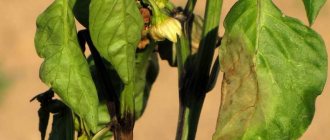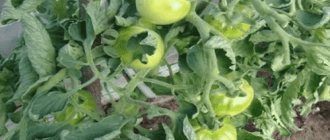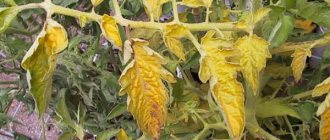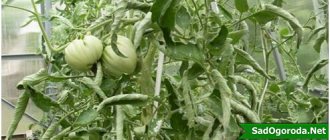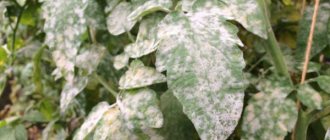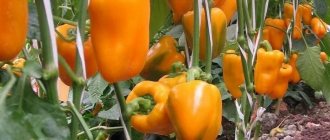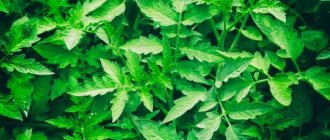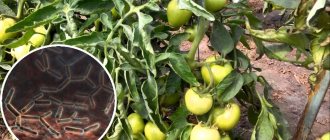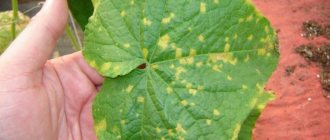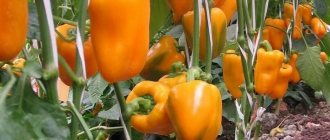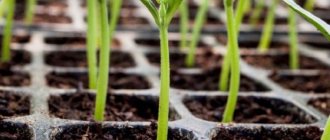The fungal disease septoria (also known as white leaf spot), unfortunately, is widespread everywhere. It does not spare any flower crops, vegetables, berry bushes or fruit trees on the site. How to recognize septoria and how to fight it?
The causative agent of the disease is numerous species of fungi of the genus Septoria, which parasitize a wide variety of cultivated plants, especially if they are weakened by a lack of nutrition, sunlight or fresh air. Optimal conditions for the development of the disease are at a temperature of 20-25°C and high humidity.
Let's look at the most common and harmful types of septoria that you may encounter in your area.
Why do peppers shed leaves?
Growing peppers is not a very easy task.
The culture is demanding in terms of soil composition, lighting, and moisture. And pests and diseases lie in wait for the vegetable throughout its development. Take a close look at the growing pepper and get a closer look at the plant. Changes in the color and shape of leaves, falling flowers and ovaries, the appearance of holes and heterogeneity of the leaf plate - all this indicates unfavorable development of the plant. The appearance of pepper signals that they should pay attention to it and provide proper assistance.
Pepper leaves falling off are often a source of confusion. It seems that a healthy green plant, planted through seedlings, took root perfectly and began to grow. And suddenly, like a bolt from the blue, the lower leaves began to turn yellow and fall off. There are several reasons for this phenomenon.
Overfeeding with nitrogen fertilizers often leads to leaf drop.
Insufficient nutrition also causes yellowing and dropping of leaves.
Pepper is very demanding when it comes to watering. With scanty watering and severe drying of the soil, the leaves begin to turn yellow and fall off.
Low air temperatures can also cause leaves to turn yellow and fall off . If the night temperature drops below 14°, then the likelihood of leaves turning yellow and dying increases sharply, since pepper is a heat-loving crop.
Verticillium wilt often affects peppers. The disease begins with apical yellowing of leaves and falling off after some time. The disease is caused by a microscopic fungus of the genus Verticillium, which lives in the soil for a long time. When planting seedlings, injury to the root system can occur, through which the plant can become infected. In greenhouses and greenhouses, peppers are more susceptible to verticillium, so disinfecting the greenhouse soil will help protect the seedlings from infection.
Viral infections
Viruses are carried by insects, so the best fight against dangerous diseases is to exterminate insects and follow agricultural practices. The causative agents of such infections cause complex plant pathologies that cannot be treated.
Tobacco mosaic
It is most dangerous for greenhouse peppers and is caused by the Tobacco mosaic virus. The infection can be recognized by marbled spots on the leaves and necrosis along the central veins of the leaf blades.
Leaf curl
An incurable infection that manifests itself in different forms:
- brown curly - visible at the budding stage, starts from the lower tier, leaves and shoots curl and turn brown;
- yellow – the plant turns yellow and growth stops;
- dwarf - peppers lag behind in development, leaves are deformed, there are no ovaries.
Plants are removed from the beds, the remaining plantings are treated with Fitoverm and Aktara.
Stolbur (phytoplasmosis)
Stolbur is conditionally classified as a viral group of diseases, since the disease is caused by mycoplasmas (hence the second name - mycoplasmosis).
They carry leafhopper pathogens; the infection cannot be treated.
Signs:
- Corrugated leaves appear on the upper tier of bushes and curliness is noticeable;
- the foliage dries out;
- the infection gradually goes down, covering the entire plant;
- the peppers set ugly, deformed, tiny.
In addition to insects, peppers become infected from weeds - thistle or field bindweed. Affected bushes are pulled out and destroyed. Plantings are treated with any fungicide.
Streak
If red streaks appear on the top leaves and shoots of the pepper, it means the plant has been infected by the strika virus. The leaves gradually become deformed and the plant withers.
Urgent measures: destroy the affected bushes, treat the soil with a pink solution of potassium permanganate.
Why leaves curl with photo reasons
Sometimes you can observe curling of pepper leaves, which starts from the apical leaves.
Deformation of the leaf blade leads to reduced plant growth, susceptibility to diseases, inability to set fruit, and subsequently lead to the death of pepper. The following causes of this disease can be identified. Shortage
lack of necessary
macro- and microelements
leads to depletion of plants, twisting and deformation of leaf plates.
Fertilizing with complex fertilizer formulations often eliminates this problem. Potassium deficiency is one of the main causes of leaf curl.
Watering plants with an ash solution will help compensate for potassium deficiency. A glass of ash is sifted into a bucket and filled with water. After stirring, leave for 2-3 hours. Then water the pepper in a liter jar under each bush. You can also use ready-made potassium nitrate, which is dissolved according to the instructions. A half-liter jar of diluted potassium nitrate is added to each plant.
Leaf damage by pests is another reason leading to leaf deformation. Aphids and spider mites are the most common diseases of pepper. Aphids are small organisms that feed on the sap of young shoots and leaves.
If plants are severely infested with aphids, then deformation and yellowing of the leaves and subsequent death of the plant are possible soon if measures are not taken. Spider mite infestation can be identified by the appearance of small cobwebs. If you look closely, you can see small pests smaller than 1 ml on the leaves.
The mite parasitizes the leaves, causes them to curl, darken the leaf blades, plant growth slows down and soon dies.
Deformation and curling of leaves can be caused by larvae of root parasites located in the soil. They feed on the juices of the root system of a young plant. Gradually, the leaves curl up, the pepper withers and dies. For example, the larvae of the cockchafer can destroy an entire plantation of young plants in a short period of time.
Bacterial
Bacterial diseases of sweet pepper are similar in description and external signs to many fungal infections. Therefore, it is often difficult to differentiate the type of phytopathology. In the fight against pepper diseases, it is better to use drugs that simultaneously have antifungal and antibacterial effects.
Bacterial canker of bell pepper
Pepper disease is caused by the bacteria Clavibacter michiganensis. Bacterial cancer is typical for crops grown in southern regions and greenhouses.
The leaves become discolored, fall off, and necrotic spots 1-3 cm in size appear on the fruits. At the initial stage of disease development, the bushes are treated with copper-containing preparations or Fitolavin.
Black bacterial spot
The disease is caused by the bacterial organism Xanthomonas vesicatoria. Black, watery spots form on infected leaves and stems. Affected areas on leaf blades are usually located along the veins.
Convex black dots form on the fruits, which gradually grow. The surface of diseased peppers becomes rough. The spots turn into ulcers, due to which the fruits begin to rot.
Rapid proliferation of bacteria occurs in humid conditions at temperatures from +25 to +30 degrees.
To combat the disease, fungicidal agents are used: Abiga-Pik, Bordeaux mixture.
Prevention of black bacterial spot comes down to treating seeds before sowing, maintaining crop rotation, and spraying with Fitolavin.
Why do the lower leaves of pepper seedlings turn yellow, reasons with photos
Sometimes, with proper care and watering, the pepper stops in its development, the lower leaves begin to turn yellow and fall off. Let's consider the reasons for this phenomenon.
A lack of micro- and macroelements can cause the lower leaves of seedlings to turn yellow.
“Uncomfortable” conditions for keeping seedlings .
Dry soil, poor lighting, excess moisture, bright sun, dry air, temperature changes - all this can cause “dissatisfaction” of pepper seedlings. So plants react to unfavorable factors by yellowing the lower foliage. In order for seedlings to grow well, you need to water them with warm water and not keep them on a cold windowsill. If yellowness of the lower leaves begins to appear, you should feed the seedlings with any complex fertilizer.
Fusarium or wilt is a fungal disease that affects plants. The fungus disrupts the nutritional exchange between the root system and leaves. In a short time, the lower leaves begin to turn yellow, which quickly fall off and the plants wither. Intensive watering does not help in this situation. It is better to remove the diseased plant immediately so that the fungus does not spread to its neighbors.
Improper watering
The plant should be watered with settled warm water. This should be done early in the morning or in the evening, when the sun is no longer active. Water can be collected in a large container in the evening and allowed to warm up under natural conditions. Then it will accept the air temperature, which will have a positive effect on the growth of the crop.
Watering should be done when the soil is dry. The leaves of pepper seedlings also get sick from too wet soil. Excessive watering should not be allowed, as this can lead to the development of fungal infections.
Why pepper leaves turn white, reasons with photos
The most common reason for changes in leaf color in peppers is improper cultivation practices or a lack of certain microelements. Plants let us know about their distress by changing the color of their leaves.
Chlorosis is a violation of photosynthesis and the formation of chlorophyll in leaf blades. Leaf discoloration may be due to poor soil composition, when the soil lacks iron, magnesium, nitrogen or other elements.
Often the whitening of plant leaves is associated with sunburn . This happens in bright sunny days after watering the pepper. Droplets of water, like a lens, attract the sun's rays, causing burns to tender young leaves.
Why spots appeared on pepper leaves, reasons with photos
Pepper reacts to a lack of calcium, iron, phosphorus, potassium, magnesium, nitrogen and other minerals in the soil by changing the color of the leaf blade. The appearance of spots of various colors: from whitish to dark brown. Complete complex fertilizers for garden crops will help replenish mineral deficiency. But the appearance of spots can also be associated with many diseases that affect peppers.
Septoria or white spot is caused by a pathogenic fungus. Unstable weather, rain followed by intense heat, is the best time for spores to spread and infect plants. At the beginning of the disease, white spots with a dark halo appear on the leaves. They are then covered with small black spores. Then the spores infect the stem and fruits.
Sclerotinia or infection by marsupial fungus occurs in many vegetable crops, as well as peppers. The spores penetrate the leaf blade, forming white spots with a dark core. Without treatment, the plant quickly weakens, soon becomes completely covered by the disease and dies.
Late blight or brown rot is the most common fungal disease among garden crops.
It doesn't bypass pepper either. The disease quickly covers the entire plant and can destroy all plantings in 2-3 days. First, brownish spots appear on the lower leaves, which gradually merge into one whole. The developing mycelium of the fungus forms a whitish coating that grows on the upper surface of the leaves. The fungus affects shoots, flowers and even developing fruits. The leaves wither and dry out. Necrosis of the entire plant gradually occurs.
Infection with late blight is possible from nightshade plants (tomatoes, potatoes, eggplants) planted next to peppers. Unstable weather with sudden changes in temperature, heat with high humidity, prolonged rains - all this favors the spread of fungal spores and rapid infection.
Bacterial spot appears on leaves in hot weather after rains. The microorganism lives in the soil and quickly spreads to plants under favorable conditions. Initially, yellow-brown spots appear on the leaves, gradually they grow, absorbing more and more of the surface of the leaf plate. As a result, the leaves dry out, become red-brown in color and fall off. Mosaic spot mainly affects plants in greenhouses. The virus quickly covers the plant and infects nearby plants. Light spots appear on the leaf blade in the form of mosaic patterns. The disease is very dangerous. It is better to immediately remove the diseased plant and not expose other plants to the risk of infection. Alternaria blight or dry spotting is caused by the Alternaria fungus. The spores cause irregular dark brown concentric circles on the underside of the leaf blade. Gradually they consume the stem and even ripening fruits. The plant dries out and dies
Classification of diseases
Experts identify several groups of diseases that affect vegetable and horticultural crops (including bell peppers). The division is based on the type of pathogen.
Types of diseases:
- fungal;
- bacterial;
- viral;
- non-infectious diseases.
Most often, summer residents encounter fungal infections, which are considered the most common. The culprit is a large number of different fungi, the spores of which are carried by precipitation, wind, insects, and are stored in the soil and plant debris.
On a note! The share of fungal infections among all other plant diseases is 80%.
Viral and bacterial diseases are less common, but they are no less dangerous than fungal ones. Another difficulty is that many infections caused by viruses and bacteria have vague symptoms and are often not treatable.
The cause of non-infectious crop diseases is violations of the agricultural technology of bell pepper. The blame here lies with the summer residents, who did not supervise the plantings and did not provide them with proper care.
Why do the top leaves of peppers curl, reasons with photos
Uneven increase in leaf blade in young plants . This phenomenon should not be feared. The process is physiologically justified: for some reasons, active growth of the central leaf vein is observed. As a result, the outer edges of the sheet acquire some disproportion with deformation, which goes away on its own over time.
Lack of light (plants grow in the shade) often causes leaves to curl.
Cool summers are one of the main reasons for uneven development and curling of the upper leaves on peppers.
Potassium nitrate helps with initial deformation and leaf curling. A spoonful of fertilizer is stirred in 5 liters of water. After watering the peppers, pour the resulting solution under the root.
Powdery mildew
A sign of this disease are small white spots that gradually spread to the entire leaf. It slows down the growth of the plant and gradually leads to its death. The leaves look like they are sprinkled with flour.
Why is there a white coating on pepper leaves, reasons with photos
Powdery mildew on pepper leaves looks like a white powdery coating. Fungal conidiospores of the pathogen thrive in greenhouse conditions. If the greenhouse is not ventilated, warm and humid air will encourage the spread of spores. In a very short time, the leaves become covered with a white coating. The disease spreads quickly and can affect a large area of plants in a short time.
Main signs and symptoms of diseases
The first sign of any infection is stunted growth . The bushes become weak and lethargic, the leaves dry out and turn yellow. Fruits also signal illness: with some diseases they become wrinkled, with others they become covered with a light coating.
Most diseases are visible to the naked eye, so it is important to regularly inspect the bushes for characteristic signs.
Why do pepper leaves turn pale?
If pepper seedlings are planted in the ground without prior hardening, the tender leaves may turn white under the sharp influence of new growing conditions (open sunlight, wind, sudden changes in temperature). When planted in a permanent place of growth, young plants experience severe stress. Therefore, you should gradually accustom the plants to their new place of residence: 7-10 days before planting, take the plants out into the fresh air for a while.
Who eats pepper leaves, reasons and examples with photos
Damaged pepper leaves, holes, and gnawed surface of the leaf blade are the result of the work of pests that willingly eat the succulent foliage of young plants.
The Colorado potato beetle and its larvae mainly feast on the leaves of nightshades: eggplant, tomatoes, potatoes. If pepper grows next to these crops, the aggressive beetle can spread to it.
Slugs, garden snails and woodlice love to eat the succulent leaves of plants, and if peppers get in their way, damage to the leaves can be expected.
Pests choose plants that grow in the shade, where it is warm and humid.
The green weevil is a big fan of green spaces. Indiscriminately eats the leaves of garden and vegetable crops. If you look closely, you can see a small emerald-colored bug destroying green leaves.
What plants suffer from septoria?
Mushrooms of the genus Septoria are dangerous for cereals, tomatoes, celery , fruit and berry crops: apple, pear, quince, grapes, raspberries, gooseberries, currants .
The disease spoils the decorative appearance of roses, lilacs, rhododendrons, spirea, phlox, peonies, chrysanthemums, lupins and other plants.
Holes on pepper leaves, reasons with photos
Hollowed leaves on peppers are often a concern for gardeners.
And this is justified. You should carefully examine the damaged sheet plates, find out the reason for the appearance of holes and take the necessary measures. If holes appear on the leaves without a colored border, and the leaf seems to be eaten unevenly from different sides, most likely uninvited guests have come to your garden bed - those who like to feast on greenery. By moving the leaves aside, you can see small bugs, slugs, snails, etc.
Holes with protrusions, tubercles, colored borders and colored halos can result from aphids, spider mites, or are associated with fungal diseases.
In any case, you should help the plant get rid of uninvited guests. Collecting leaf beetles, caterpillars, snails, slugs by hand, using chemical or biological means of protection, folk recipes for pest control is the choice of every gardener.

